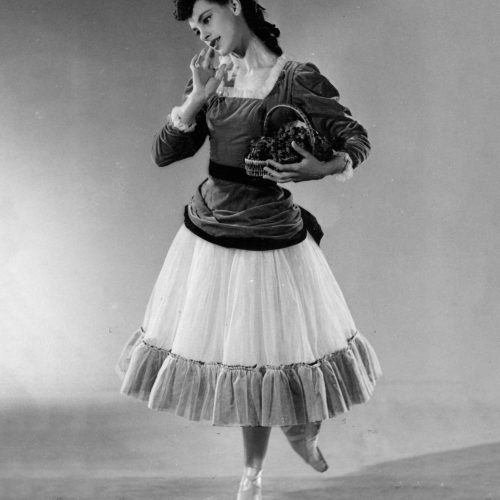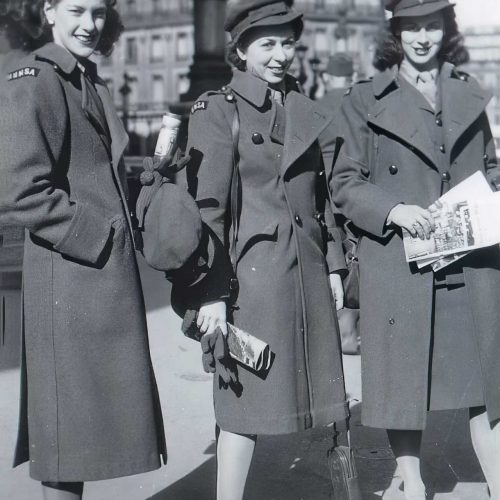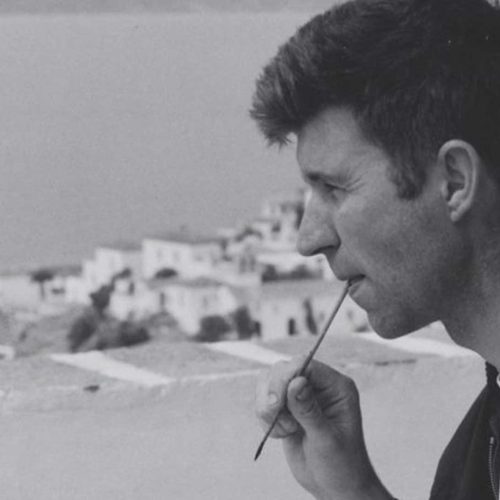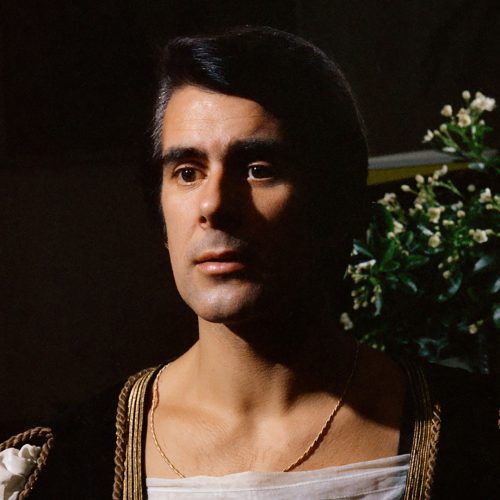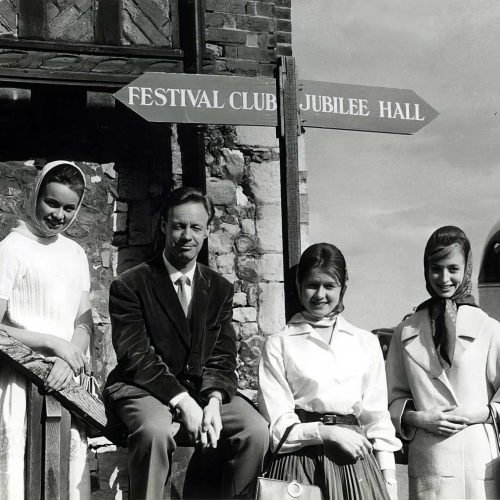Pauline Clayden
Pauline Clayden was born in 1922. Here she talks to Patricia Linton about her student days, and moves on to her dancing life up until joining the Sadler’s Wells Ballet in 1942. There was great uncertainty for all at the start of World War Two, and Pauline’s excellent memory, combined with her clarity, modesty and humour, shines a light on the assembling and disassembling of various groups of dancers.
The episode is introduced by Patricia Linton in conversation with Natalie Steed.
First published: July 1, 2025
Biography
Pauline Clayden was born in London in 1922, studying at the Cone Ballet School before her debut with the Covent Garden Opera in 1939. Later that year she joined Anthony Tudor’s London Ballet and stayed with them when they merged with Ballet Rambert. In 1942 she joined Sadler’s Wells Ballet at the height of their extraordinary commitment to ameliorating the ravages of wartime Britain. She was a firm favourite of Ashton’s, and not just because she was so able artistically and temperamentally to successfully take on the roles he had created
for Fonteyn. She was a master at understanding the style and underlying pulse and meaning of many different choreographers and approaches. She was a key member of the company for the ENSA organised tours of Belgium and Paris in early 1945 and also of Germany at the end of that year.
In February 1946 when the Sadler’s Wells Ballet re-opened the Royal Opera House at Covent Garden, she was back on the stage where she had started in 1939. Her tutu for the Fairy of the Song Birds, which she danced in the Prologue of The Sleeping Beauty on that memorable night, is now part of the Royal Opera House Collections. Her roles included Una in The Quest, Ophelia in Hamlet, Chief Child of Light in Dante Sonata, Flower Girl in Nocturne, Waltz in Les Sylphides, Princess Florine in The Sleeping Beauty, the Suicide in Miracle in the Gorbals, roles in The Fairy Queen, La Boutique fantasque, Les Sirènes and dozens of others, are an amazing testament to her professionalism and versatility. When she retired in 1956, in order to have a family, she received a letter from Ninette de Valois acknowledging her gratitude for all that she had contributed to the company.
During her career with the Sadler’s Well Ballet, Pauline Clayden compiled meticulous and perfectly written notebooks in which she recorded the details of every performance in which she danced, including cast changes due to injury or illness which did not make it into the programme. These notebooks are gold dust and are deposited in the Archives of the Royal Opera House.
Transcript
In conversation with Patricia Linton
Pauline Clayden: I am afraid I belong to that awful group of small children who were put on their toes much too early and this was a little dancing school over at the Archway.
It was my mother really that kind of kind of pushed me. I don’t think that I really knew what I was doing, quite honestly, I didn’t know anything about ballet, or dancing, or anything else. But, eventually I went to Cones School and I remember Mummy very proudly saying ‘and she’s been on her toes’ and Miss Gracey [Grace Cone] said ‘and she’s coming off them’ [laughing] and I was a contemporary of Julia Farron, and Julia was a born dancer, I have the most marvellous photograph which is somewhere here, when we were about ten, and there were five of us in a row, and Julia is in the middle on a beautifully turned-out foot with her head on one side, beautifully posed, and I am on the end with a completely turned-in foot, and haven’t a clue, I really hadn’t a clue.
From that, Mummy kind of pushed me. And she must have known something about dancers and I can’t imagine how she got to know, because one of the first things that has kind of jogged my memory was a photograph that was taken for The Dancing Time’s Jubilee. It was a dinner, and it was either at the Dorchester or The Grosvenor House, I can’t honestly remember now where. And Mummy thought it would be nice if we all went. And Daddy and Mummy, and my sister and I went and I do very distinctly remember going into the ladies cloakroom and Mummy pointing our people to me and saying, “That’s Markova and that’s…etc” And, I mean, the names didn’t mean anything to me, but how she knew, I’ve no idea. I don’t know what her interest could have been. And I must have been about thirteen at the time.
And at fourteen she became very ill and she died when I was fifteen so I never really got round to discovering. I knew that she kind of pushed me a little bit and I think she probably would have been a dreadful ballet mother. I have a feeling. From the displays that I can remember at Cones. She would always pull my hair in a different direction to everyone else’s. I wasn’t allowed to have it with a centre-parting like everybody else in the shows. Mine had to be one the side with, like a comb put it and a lump pulled down. And I looked absolutely dreadful. And this kind of carried on.
With Mummy dying, it was a slight kind of problem as to what was going to happen, and [the] Cones more or less took me under their wing and I remember very much later, an extraordinary thing: Daddy saying would I like to go and live with the Cones? I said no – I was terrified of Miss Gracey, I was very frightened, and I said no, I would hate that. It was after Amanda was born, my first child, was born, and I took her to the theatre and was sitting having a coffee with Dame Ninette [de Valois] and somehow or other it came up about Cones School and she said something about they wanted to adopt you, and it was bombshell to me, I hadn’t realised that they had offered to do this, because I think it was because Daddy didn’t think he wanted to carry on paying for me to go to dancing, and I think it would probably have been a full stop, but then he realised that I did love it and he thought, ‘give it a go for a little while’ and he did cough up the money for me to continue.
It happened that there was a Production Club performance, [at the] RAD [ The Royal Academy of Dance], and there was a little ballet that Felicity Andre had originally choreographed for herself, and a group of dancers from the Bedells School I think, and she reproduced it for the Production Club and I did her role in it, that together with another ballet called Lithographs which was by Marion Knight, which was a Cone ballet; and Peggy Van Praagh was in the audience and she picked out two people from that performance, I think Avril Kentridge was one and I was the other one and she wrote our names down on a piece of paper. About the same time – this was 1939 – [Antony] Tudor, who had run his London Ballet from Toynbee Hall, (a company I didn’t really know much about) was invited to do the ballets for Covent Garden’s 1939 [opera] season, [Thomas] Beecham was conducting, Eva Turner was singing in Turandot, [Beniamino] Gigli was singing and there were marvellous casts, and there was to be a very big ballet in Aida and a very big ballet in Parsifal. He said to Peggy Van Praagh, ‘where can I find extra dancers?’ and she immediately produced these two names and said one is at Cones School and one, I think, was Sheila Elliot-Clark, I am not quite sure now where Avril was. There was great excitement at Cones School because Antony Tudor was coming to the school to choose people for his opera season and [the] Cones bought forth their favourite little dancers and there were certainly people with great names there at the time – there was Glynis Johns, was a contemporary, Belita [Jepson-Turner], the skater, was another contemporary, Gladys Gills was another girl. At the end of this class Antony looked at his piece of paper and said ‘where is Pauline Clayden’ and I was somewhere very, very far at the back and, much to everybody’s amazement, he said ‘I would like Pauline’.
And, lo and behold, I went along to rehearsals and immediately kind of fell into place and thought ‘this is super’. I just felt I belonged there. It was absolutely super, and we did these ballets and we had lots of, kind, of amusing times because some of these operas had been done for years and the same old costumes had been used: the old skips were brought out with old, old kind of costumes for the pages in Parsifal, kind of red tunics, and we all had blonde wigs.
And the idea in Parsifal was that we just filled in and used the stage, because we looked more presentable than the chorus to walk across as little choirboys. We were engaged to walk from one side of the stage to the other to the chapel where the choir were hidden off stage and would sing. Then, at the end of the scene, we would walk back again across the stage and disappear through the door the other side, but on this particular occasion when we walked across, somebody had locked the door and when we got there there was nothing we could do, having tried the door and nobody unlocked it. We had to turn round and walk back again and there was chaos backstage because the chorus didn’t know whether to stay on the same side, where we weren’t, or whether to rush round to other side of the stage and sing from the other side of the stage! There were many funny things that happened at Covent Garden, but I just fell into ballet at the deep end, really, I mean it was a marvellous, marvellous experience.
Patricia Linton: How old were you at this time?
Pauline Clayden: I was sixteen I think.
Patricia Linton: And living?
Pauline Clayden: And living at home with my father because my mother had died by then. Then war was declared and nobody knew what was going to happen, and Antony went off to America. Well it seemed that he said to Peggy Van Praagh when he was going to [revive the] Performance Company again that he would like me to join the Company. I didn’t know this. War was declared and we went off in all directions, everybody went and evacuated, and then [the] Cones decided that they were going to evacuate the school and I went with Cones School to the Hallams, which was between Guildford and Godalming. It had been a big domestic science college and it was taken over by the school.
I was only there two or three months, and Peggy Van Praagh and Maude Lloyd re-established the London Ballet in Antony’s name and I was called to a rehearsal and told, you know, that they wanted me to join the Company, and, of course, I was delighted because it was the beginning of my career. I can remember going up and we performed at the Arts Theatre, which was the Arts Theatre Club, and although everybody said the Windmill was the only theatre open in London, it wasn’t, because the Arts Theatre was still functioning. We did what were called Lunchtime Ballets, and so we did hourly performances. They lasted an hour with probably quarter of an hour in between each one, and we started performing at, I can’t remember, probably twelve, one, two, I don’t know. Then we would rush to get home before the black-out and before the bombs started falling. This happened day after day and certainly we had war experiences and I can very distinctly remember in Les Sylphides, when it came to all twelve of us on the stage with our back to the audience, doing the port de bras with our heads over and hearing this terrific whistle of this bomb coming. We all kind of froze and waited, wondering whether it was going to be near or whether it was going to shatter the theatre or what. I think if one person had run the whole house would have disappeared and been under their seats or whatever, but nobody did. We just froze in our position, we heard the bang go and the whole theatre rocked. We knew that it had landed, and just carried on and the music went on and we carried on.
It was an interesting time, but then it [the Lunchtime Ballets] was a very strange kind of set up because at the Arts Theatre, Harold Reuben – who was running the kind of theatre, he engaged [Ballet] Rambert as a second company, and then [he] formed a third company which was the Arts Theatre Company, which Keith Lester was in charge of and choreographed for.
Patricia Linton: Why did he make a third company as well?
Pauline Clayden: I don’t know. He had the Ambassadors’ Theatre and he had one lot of dancers like in the [theatre] club – you had to join as a member [of the club] to go to the performances but I think it was very little, and then for the general public he would have the Ambassador’s Theatre. Then the idea was that the third company would be on tour. It was a monthly contract of which we should have earned I think, something like three pounds a week, but he would find engagements for us for the first six weeks and then we had already worked off our minimum, which was thirty bob a week. On one occasion I know Peggy van Praagh somehow or other – I don’t quite know how she managed it – got an engagement for us at the Alexandra Theatre in Birmingham, and we went up and I know my salary was five pounds a week and I thought it was absolutely marvellous.
This went on until he found couldn’t run the three Companies, and he amalgamated Rambert with the London Ballet. Now the London Ballet was made up of all the people that really couldn’t stand Mim, Madame [Marie] Rambert. They really had fallen out with her at some point or other, and there were a lot of people there that, when the amalgamation came, they just left, so there were very few of us, really, from London Ballet that went on to amalgamate with Rambert. Maude Lloyd stayed of course, and Peggy van Praagh, and I think there were only four in the corps de ballet – I think the rest had all left.
And so we went on until things got absolutely impossible and we just decided that we would all walk out of our contract. Unfortunately all the repertoire was tied up with the contract and we couldn’t start another company. To begin with we went into The Tales of Hoffman which was by Albion Operas, and it was put on at Strand Theatre and Henry Wendon was singing Hoffman followed by Isaacs – I think his name was Isaacs – and the understudy that came a little later on, and also came on tour, was Peter Pears. Nobody had known him, he had never set foot on a stage before, but by the time he got Hoffman on the tour – I think we were in Hull – both Hoffmans were off and Peter Pears was on, and it was his very first stage performance, and he knew everything, he was word perfect, and everybody enjoyed his performance very much. This was before he knew [Benjamin] Britten, and so this went on.
When we came to the end of our run of Hoffman. Most of the ballets that were performed in Hoffman, Frank Staff choreographed, he had taken over all the choreographing, and he really I suppose took Antony’s place once Antony went to America. I mean he took over choreographing the ballets. We performed to records, and you know they were ’78 records, and I think they must have had two turntables, because I certainly remember records, with little marks on that, where one finished, they had to put it on the other one to keep the music continual.
Patricia Linton: So in the wings, in the prompt corner – the stage manager would put on a record and at the end of the records that would be the end of the dance…
Pauline Clayden: Yes, that’s right. On one particular occasion I can remember, very distinctly, in Enigma Variations, the Dorabella solo [Elisabeth] Schooling did; it was a solo for her, and I was told to understudy it – and I thought, well I will got up in the wings and just see how does she know when to start it, because it was one of those things that you had to be on the stage on the first count, I thought, ‘I wonder how she gauges this’, and instead of the Dorabella music I heard, ‘and this is how things stood, the bird was on one branch of the tree and the cat on another’, and, of course, they had muddled the records up, it was still number three record or whatever number it should have been, but they had mixed up the Peter and the Wolf records with the Enigma records. There were always kind of little accidents happening and we had lots of laughs at various things, but when the kind of Company folded we were all told to go off and find our own jobs.
The transcript of this podcast may have been lightly edited for ease of reading.

